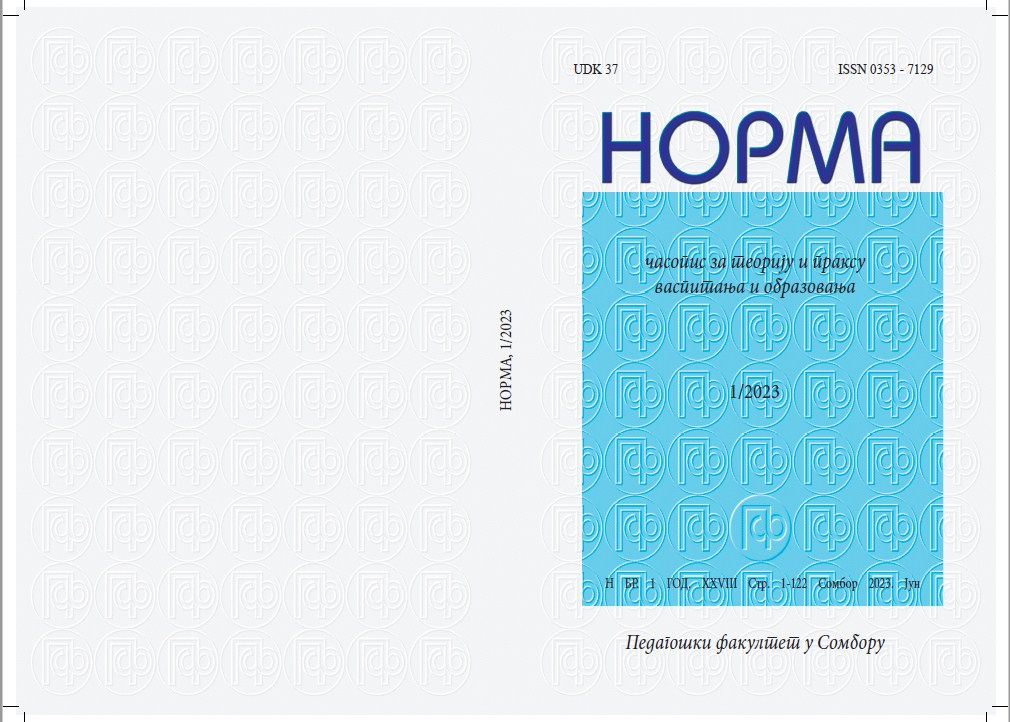Примена социјалних прича у раду са децом са поремећајем из спектра аутизма: компарација перцепције наставника и родитеља
Sažetak
Поремећаји из спектра аутизма (ПСА) представљају групу неуроразвојних поремећаја које карактерише дефицит у социјалној комуникацији и интеракцији, те присуство ограничених, репетитивних образаца понашања, интересовања или активности у раном развоју, а што негативно утиче на развој особе у свим доменима. Како дефицити у социјалној интеракцији значајно отежавају прилагођавање особа са ПСА окружењу, а социјалне вештине не могу спонтано научити, потребно је применити различите интервенције. Социјалне приче се препоручују у раду са особама са ПСА, мада се мора истаћи да су резултати истраживања о ефикасности ове интервенције опречни. Како наставници и родитељи имају значајну улогу у животу детета, а често на различит начин перципирају дететово понашање, написан је рад са циљем компарације искустава наставника и родитеља у примени социјалних прича код деце са ПСА. На основу анализе обухваћене литературе којој се приступило путем електронског претраживача Google Scholar, може се закључити да наставници и родитељи деле мишљење о позитивном ефекту социјалних прича у домену понашања и социјалних вештина деце са ПСА. Било би значајно да се у будућим истраживања са темом евалуације примене ове интервенције, осим објективних чинилаца који указују на промене у дететовом понашању, мишљења родитеља и наставника такође узму у обзир приликом евалуације, како би се стекао реалан увид у ефикасност ове интервенције, те да би се евентуално унапредио њен садржај и начин коришћења.
Reference
1. Acar, C., Tekin-Iftar, E., & Yikmis, A. (2016). Effects of Mother-Delivered Social Stories and Video Modeling in Teaching Social Skills to Children With Autism Spectrum Disorders. The Journal of Special Education, 50(4), 215–226. https://doi.org/10.1177/0022466916649164 https://www.researchgate.net/publication/301781512_Effects_of_mother-delivered_social_stories_and_video_modeling_in_teaching_social_skills_to_shildren_with_Autism_Spectrum_Disorders
2. Adams, L., Gouvousis, A., VanLue, M., & Waldron, C. (2004). Social story intervention: Improving communication skills in a child with an autism spectrum disorder. Focus on Autism and Other Developmental Disabilities, 19(2), 87–94. https://doi.org/10.1177/10883576040190020301
3. Aldabas, R. (2019). Effectiveness of social stories for children with autism: A comprehensive review. Technology and Disability, 31(1-2), 1–13. https://doi.org/10.3233/tad-180218
4. Ali, S., & Frederickson, N. (2006). Investigating the Evidence Base of Social Stories. Educational Psychology in Practice, 22(4), 355–377. https://doi.org/10.1080/02667360600999500
5. Alotaibi, F., Dimitriadi, Y. and Kemp, A. E. (2016) Perceptions of teachers using social stories for children with autism at special schools in Saudi Arabia. Journal of Education and Practice, 7 (11), 85-97. https://doi.org/10.52839/0111-000-077-005
6. Cavanaugh, C. M. (2012). Teachers perceptions of interventions for children with autism in a school setting, [Doctoral dissertation], State University of New York. https://soar.suny.edu/bitstream/handle/20.500.12648/4674/edc_theses/122/fulltext%20(1).pdf?sequence=1
7. Cigrand, D. L. (2011). School Counselors’ Use of the Combination Social Stories™ and Video Modeling Intervention for Social Skills Development of Students Diagnosed with Autism Spectrum Disorders: A Qualitative Criticism of the Perceptions of Multidisciplinary Team Members. [Doctoral Dissertation]. The University of Iowa. https://www.proquest.com/openview/00ba0f709e8fc35cfc2e2b4d81a6b2a3/1?pq-origsite=gscholar&cbl=18750
8. Dodd, S., Hupp, S. D. A., Jewell, J. D., & Krohn, E. (2007). Using Parents and Siblings during a Social Story Intervention for Two Children Diagnosed with PDD-NOS. Journal of Developmental and Physical Disabilities, 20(3), 217–229. https://doi.org/10.1007/s10882-007-9090-4 https://www.researchgate.net/publication/225109898_Using_Parents_and_Siblings_during_a_Social_Story_Intervention_for_Two_Children_Diagnosed_with_PDD-NOS
9. Frolli, A., Savarese, G., Di Carmine, F., Bosco, A., Saviano, E., Rega, A., Carotenuto, M., & Ricci, M. C. (2022). Children on the Autism Spectrum and the Use of Virtual Reality for Supporting Social Skills. Children (Basel, Switzerland), 9(2), 181. https://doi.org/10.3390/children9020181 https://www.mdpi.com/2227-9067/9/2/181
10. Hutchins, T. L., & Prelock, P. A. (2012). The social validity of Social Stories™ for supporting the behavioural and communicative functioning of children with autism spectrum disorder. International Journal of Speech-Language Pathology, 15(4), 383–395. https://doi.org/10.3109/17549507.2012.743174 https://www.researchgate.net/publication/233874565_The_social_validity_of_Social_Stories_for_supporting_the_behavioural_and_communicative_functioning_of_children_with_autism_spectrum_disorder
11. Kodak, T., & Bergmann, S. (2020). Autism Spectrum Disorder. Pediatric Clinics of North America. https://doi.org/10.1016/j.pcl.2020.02.007
12. Kokina, A., & Kern, L. (2010). Social Story interventions for students with autism spectrum disorders: a meta-analysis. Journal of autism and developmental disorders, 40(7), 812–826. https://doi.org/10.1007/s10803-009-0931-0 https://d1wqtxts1xzle7.cloudfront.net/83204854/Kokina___Kern_2010-libre.pdf?1649086509=&response-content-disposition=inline%3B+filename%3DSocial_Story_Interventions_for_Students.pdf&Expires=1684672827&Signature=ZL40y2yrEmQm08WU3iwF9Zheplasyc39stQo~CZDZp~B8ZenFgrjnJMQLK~0Fb13xvOkdz8jjMKD1Z5NCFYK1lEOJ7G0P7QRjILTEYtT3py6B-ljUjC9N3CDPA73hTG81andgOp5ccS~eIYFVH-B5hwNhhhizgsBJ3B3-QEREmuNgnYXCeZcc8iVNTCxwAvCzgvWtEq7bf3X2q2yrQR7edfoyV5chy~xvp3ZXZOpFICb98W4lbzMIyCe9cn7SpTM7X90UHm7TbQWXDk3FD9PB-JuhZId-fSkSLPh-rQQsrPxklSI5Ge7oAFNh5LrjEBi3jty1-r2uBVToQ0ZzUz5-g__&Key-Pair-Id=APKAJLOHF5GGSLRBV4ZA
13. Lešković, K. (2016). Socijalne priče kod poremećaja iz spektra autizma [Master rad]. Sveučilište u Zagrebu. https://repozitorij.erf.unizg.hr/islandora/object/erf%3A50/datastream/PDF/view
14. Reynhout, G., & Carter, M. (2008). A Pilot Study to Determine the Efficacy of a Social StoryTM Intervention for a Child with Autistic Disorder, Intellectual Disability and Limited Language Skills. Australasian Journal of Special Education, 32(2), 161–175. https://doi.org/10.1080/10300110802047210
15. Reynhout, G., & Carter, M. (2009). The use of Social Stories by teachers and their perceived efficacy. Research in Autism Spectrum Disorders, 3(1), 232-251. https://doi.org/10.1016/j.rasd.2008.06.003 https://d1wqtxts1xzle7.cloudfront.net/70231264/j.rasd.2010.10.00320210925-24353-1l2f07m-libre.pdf?1632623695=&response-content-disposition=inline%3B+filename%3DEvaluation_of_the_efficacy_of_Social_Sto.pdf&Expires=1684672875&Signature=aWruh5nRbwJYmxDt1GKAqaemnVMA98UI1a1vaK0C4~qOds980BqIfXbpNyxqd7dFsiYwZL-C1E~Fr6zRonPLSFjH52tWN9sPr8YHzoboPeuTf4mqFMw8NGf2y4mGuPzzCcZC~RemFXgAnmXGC2Rgzb390spYh0AFnl9GDUtLz7xFCEx72lA4BqYasqYvAsj1~RDomFYM6TsM0L6fsZgIdE1Y46ymyrH0I8CGyvWfzyspHdHLD3uHnarUh7uH0lzQQ2YvRLU-h-0XRr8yHRMITO446yVW10w4BxiXJ3MbV2unXypPNhjKLsd2t~NSp3YqwjLnms6mkpfSzJJEAKrQzw__&Key-Pair-Id=APKAJLOHF5GGSLRBV4ZA
16. Scattone, D., Wilczynski, S. M., Edwards, R. P., & Rabian, B. (2002). Decreasing disruptive behaviors of children with autism using social stories. Journal of autism and developmental disorders, 32(6), 535–543. https://doi.org/10.1023/a:1021250813367 https://d1wqtxts1xzle7.cloudfront.net/69795662/Decreasing_disruptive_behaviors_of_child20210917-9590-9xr3l8.pdf?1631871387=&response-content-disposition=inline%3B+filename%3DDecreasing_disruptive_behaviors_of_child.pdf&Expires=1684672907&Signature=ZbwdAbWPWyouGlLtzdD-5l3QTQCUphMW~mxPevpicTuu-bHRfXX7lTnZJzjUEWLvTUGT6oyl2JAQ6it-8NQ229X3S-uxaNwF73qUmajc3fy8Db~o0IDbUjhi8VvAiCC92WV1ruNucvM9L9uNcstUIXM6Q-9ECMdUmEll23JDKtZgr89aDP766TlYIJrRKueDqfDwvqzoEHfIjRQURaMX4lAPpXTdeMJ7nNefOBp-lU~tOgJAq0FA5VECIoz3ZqxW500-sPzg~FFHNcmm9W11ZP0GVo5XkKZ6yrEOEQ4gITjmJlJJc~0wRBJHihZ89UPz~53hkgn-6mheJc6GmmvVvw__&Key-Pair-Id=APKAJLOHF5GGSLRBV4ZA
17. Sansoti, F, J., Powell-Smith, K, A., & Kincaid, D. (2004). A research synthesis of social story interventions for children with autism spectrum disorders. Focus on Autism and Other Development Disabilities, 19(4), 194–204. https://doi.org/10.1177/10883576040190040101
18. Moody, C. T., & Laugeson, E. A. (2020). Social Skills Training in Autism Spectrum Disorder Across the Lifespan. Child and adolescent psychiatric clinics of North America, 29(2), 359–371. https://doi.org/10.1016/j.chc.2019.11.001 https://communitybehaviorservices.com/wp-content/uploads/2020/05/36-Moody-Laugeson-2020.pdf
19. Marušić Dalić, S. (2023). Razvoj socijalnih vještina kod djece s autizmom. Varaždinski učitelj: digitalni stručni časopis za odgoj i obrazovanje, 6(11), 648-654. https://hrcak.srce.hr/file/420929
20. O. Velišek-Braško, M. Svilar, Socijalne priče kao metodički pristup u inkluziji dece iz spektra autizma. Krugovi detinjstva, 7(1), 36‒52. https://www.vaspitacns.edu.rs/obavestenja/KRUGOVI%201_2019_naslovna.pdf
21. Ђорђевић, М.,& Глумбић, Н. (2022). Израда и примена социјалних прича у раду с младим особама с високофункционалним аутизмом из перспективе студената. Узданица, 19(1), 373-393.
https://doi.org/10.46793/Uzdanica19.1.373DJ https://pefja.kg.ac.rs/wp-content/uploads/2022/07/26-Mirj%D0%B0n%D0%B0-V.-Djordjevic-Uzdanica-XIX-1-2022.pdf
Sva prava zadržana (c) 2023 Norma

Ovaj rad je pod Creative Commons Autorstvo 4.0 međunarodnom licencom.

